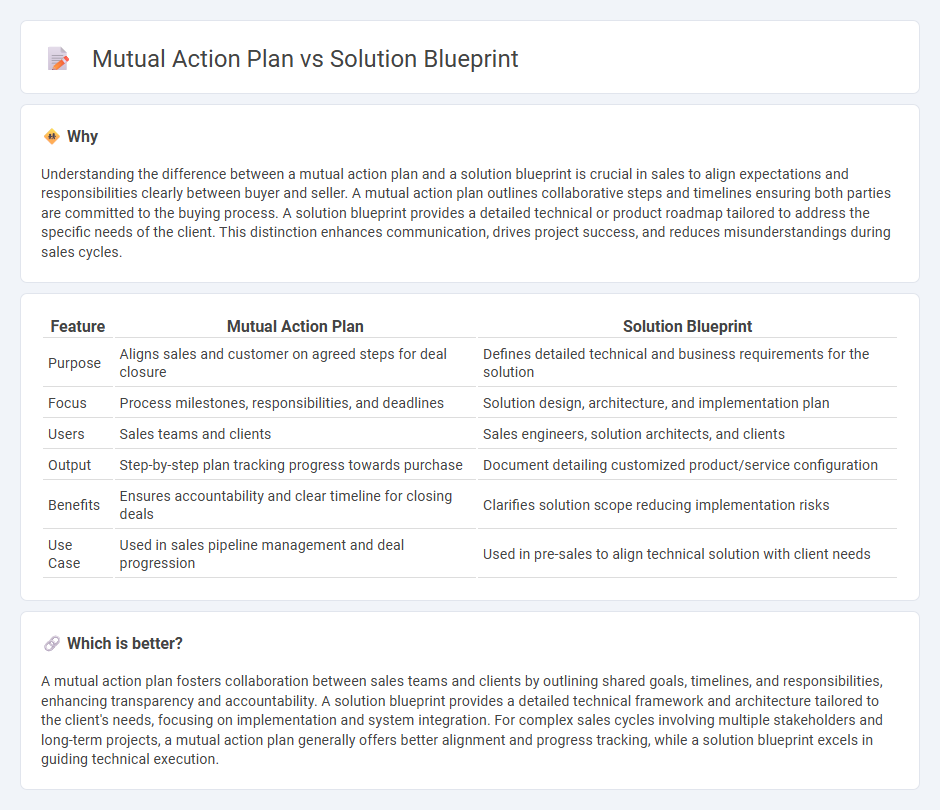
A Mutual Action Plan outlines collaborative steps between sales teams and clients to achieve shared goals, ensuring accountability and timely progress. A Solution Blueprint focuses on detailing the technical and strategic aspects of a product or service tailored to the customer's needs. Explore the benefits and applications of each approach to enhance your sales strategy.
Why it is important
Understanding the difference between a mutual action plan and a solution blueprint is crucial in sales to align expectations and responsibilities clearly between buyer and seller. A mutual action plan outlines collaborative steps and timelines ensuring both parties are committed to the buying process. A solution blueprint provides a detailed technical or product roadmap tailored to address the specific needs of the client. This distinction enhances communication, drives project success, and reduces misunderstandings during sales cycles.
Comparison Table
| Feature | Mutual Action Plan | Solution Blueprint |
|---|---|---|
| Purpose | Aligns sales and customer on agreed steps for deal closure | Defines detailed technical and business requirements for the solution |
| Focus | Process milestones, responsibilities, and deadlines | Solution design, architecture, and implementation plan |
| Users | Sales teams and clients | Sales engineers, solution architects, and clients |
| Output | Step-by-step plan tracking progress towards purchase | Document detailing customized product/service configuration |
| Benefits | Ensures accountability and clear timeline for closing deals | Clarifies solution scope reducing implementation risks |
| Use Case | Used in sales pipeline management and deal progression | Used in pre-sales to align technical solution with client needs |
Which is better?
A mutual action plan fosters collaboration between sales teams and clients by outlining shared goals, timelines, and responsibilities, enhancing transparency and accountability. A solution blueprint provides a detailed technical framework and architecture tailored to the client's needs, focusing on implementation and system integration. For complex sales cycles involving multiple stakeholders and long-term projects, a mutual action plan generally offers better alignment and progress tracking, while a solution blueprint excels in guiding technical execution.
Connection
A mutual action plan outlines collaborative steps between sales teams and clients to achieve specific objectives, ensuring alignment throughout the sales process. The solution blueprint complements this by providing a detailed technical and strategic framework that addresses client needs identified in the mutual action plan. Together, they drive efficient communication, clear expectations, and a structured path to successful deal closure.
Key Terms
Solution Blueprint: Value Proposition
A Solution Blueprint outlines a structured approach to deliver a value proposition by mapping out the specific features, benefits, and integration tactics tailored to a client's needs. It emphasizes creating clear alignment between the product's capabilities and the client's business objectives to demonstrate measurable value. Explore more to understand how a Solution Blueprint drives successful client engagements.
Solution Blueprint: Technical Requirements
A Solution Blueprint details the technical requirements, architecture design, and integration points necessary for implementing a system or product effectively. It serves as a foundational document aligning development teams on specifications, technology stacks, and infrastructure needs to ensure seamless deployment. Explore how a Solution Blueprint streamlines technical planning and execution by learning more about its components and applications.
Mutual Action Plan: Implementation Milestones
Mutual Action Plans (MAPs) define clear implementation milestones that align all stakeholders on project timelines, deliverables, and responsibilities, enhancing accountability and progress tracking. Unlike solution blueprints which provide technical design and architectural guidance, MAPs emphasize collaboration and synchronized execution steps crucial for successful adoption and deployment. Explore detailed strategies for creating effective Mutual Action Plans to ensure project success and stakeholder alignment.
Source and External Links
Key components of a solution blueprint - FactorBytes - A solution blueprint is a comprehensive guide that outlines the technical, business, and operational aspects of a solution, ensuring stakeholder alignment from inception to implementation by detailing executive summaries, solution architecture, business cases, requirements, and high-level design.
Solution Blueprint - A solution blueprint acts as a detailed action plan and roadmap for business technology implementation, guiding organizations through vendor selection, process redesign, software customization, or platform migration by thoroughly analyzing people, processes, and technologies.
Solution Blueprint Review workshops - Dynamics 365 - A Solution Blueprint Review workshop is a mandatory session that establishes project fundamentals, aligns solution design with best practices, and sets the baseline for planning further implementation activities across program, application, data, integration, test, and security strategies.
 dowidth.com
dowidth.com